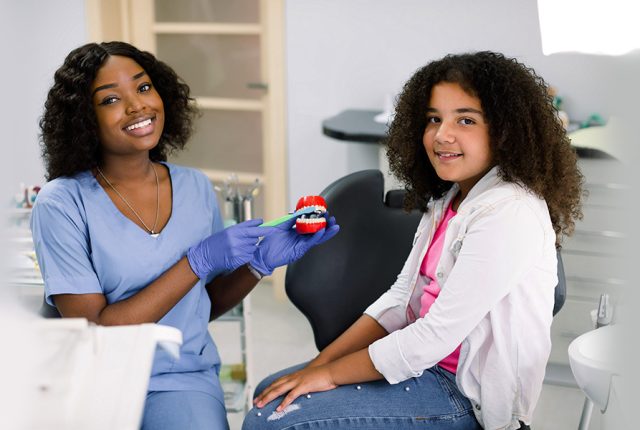In most cases, your child’s teeth will not need to be extracted. However, it may become necessary at times. Extracting an infected or decayed tooth has many more benefits than leaving it there. In this blog, we will discuss the basics of the procedure to help you make an informed decision.
When Is It Necessary to Extract a Baby Tooth?
Baby tooth extraction is usually the last resort, and should only be done in the following situations:
Tooth Decay
Decay is probably the leading cause of extractions among children. If the decay is so extensive that restorative procedures cannot help, the dentist may have to extract it.
Preparation for Orthodontic Treatment
If you plan to get braces for your child, the dentist may suggest extraction to create a space for the treatment.
Baby Teeth Failing To Fall Out On Time
Typically, baby teeth should fall out to make space for permanent teeth. Most children don’t have problems with baby teeth fail to fall out, but a good number has to visit the dentist for an extraction. If the baby tooth is not extracted, the permanent one will grow underneath it, which will affect your child’s smile.
Remove Damaged Baby Teeth
In some cases, a baby tooth may be damaged beyond repair. For example, a kid may be involved in an accident, breaking her tooth in the process. If it is broken beyond repair, the dentist will have to remove it and place a stainless steel crown as you wait for the permanent one to erupt.
Dr. Brown will never recommend early tooth extraction if there is an otherwise. However, if it’s the only option, we will ensure it is done professionally. By now, you must see why it plays a major role in oral health, so be sure to listen if the dentist suggests extraction.
Baby Tooth Extraction Procedure
There are two types of dental extractions; simple and surgical. A surgical extraction is used for impacted teeth, while simple is used for visible teeth. Here is what you can expect during the procedure:
Radiography
Most dentists usually take some x-rays to look for any other oral complications. The radiographs will also examine where the roots are positioned as well as the structure of the jawbone.
Sedation
Dental extraction could be a painful procedure, but it is not, thanks to sedation. The dentist will probably use local anesthesia. Local anesthesia is safe, and your child will not be unconscious during the extraction. However, she will not feel any pain.
The anesthesia is injected into your kid’s mouth, and it is effective for several hours. If your child has high anxiety levels, the dentist may use a combination of sedatives and anesthesia. If he does that, your child will be asleep during the extraction.
Tooth Extraction
The dentist will use the necessary equipment to remove the affected tooth. The whole extraction period does not take long, and it is pain-free. Dentists are always very careful not to damage the bone while extracting the target tooth.
Stitches
The dentist will cover the socket with a gauze piece and apply pressure to it for about 20 minutes. In most cases, stitches are not used. However, in some cases, he may have to use stitches.
Space Maintainer
If a primary molar is extracted, the dentist will need to place a space maintainer to ensure the permanent teeth grow as expected. These devices ensure that the other teeth do not migrate towards space, affecting the alignment. Space maintainers are not always necessary, but if suggested, go for one.
Post Extraction Care Tips
Moderate pain and swelling are not uncommon, but you should not let that scare you. The dentist will provide you with the means to handle the pain and other side effects associated with a tooth extraction. These tips include:
- Give your child painkillers that your dentist suggests.
- Use ice packs to help reduce inflammatory and pain.
- Ensure your child takes soft foods in the first few days.
- Avoid hard foods until your child is all healed up.
- Make sure your child does not sip with a straw for the first 24-48 hours.
Kids First Dental (Martinsville)
If you need a pediatric dentist in Martinsville, you are in the right place. We promise to provide quality services and guide your child to live a cavity-free life. If you require a baby tooth extraction in Martinsville, you can also count on us. Let us help your lovely child book an appointment now.




